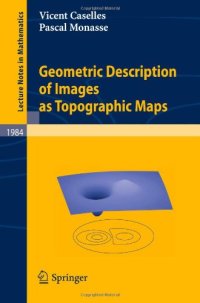
Ebook: Geometric description of images as topographic maps
- Genre: Mathematics // Geometry and Topology
- Tags: Visualization, Information and Communication Circuits, Combinatorics
- Series: Lecture Notes in Mathematics 1984
- Year: 2010
- Publisher: Springer-Verlag Berlin Heidelberg
- Edition: 1
- Language: English
- pdf
This volume discusses the basic geometric contents of an image and presents a tree data structure to handle those contents efficiently. The nodes of the tree are derived from connected components of level sets of the intensity, while the edges represent inclusion information. Grain filters, morphological operators simplifying these geometric contents, are analyzed and several applications to image comparison and registration, and to edge and corner detection, are presented.
The mathematically inclined reader may be most interested in Chapters 2 to 6, which generalize the topological Morse description to continuous or semicontinuous functions, while mathematical morphologists may more closely consider grain filters in Chapter 3. Computer scientists will find algorithmic considerations in Chapters 6 and 7, the full justification of which may be found in Chapters 2 and 4 respectively. Lastly, all readers can learn more about the motivation for this work in the image processing applications presented in Chapter 8.
This volume discusses the basic geometric contents of an image and presents a tree data structure to handle those contents efficiently. The nodes of the tree are derived from connected components of level sets of the intensity, while the edges represent inclusion information. Grain filters, morphological operators simplifying these geometric contents, are analyzed and several applications to image comparison and registration, and to edge and corner detection, are presented. The mathematically inclined reader may be most interested in Chapters 2 to 6, which generalize the topological Morse description to continuous or semicontinuous functions, while mathematical morphologists may more closely consider grain filters in Chapter 3. Computer scientists will find algorithmic considerations in Chapters 6 and 7, the full justification of which may be found in Chapters 2 and 4 respectively. Lastly, all readers can learn more about the motivation for this work in the image processing applications presented in Chapter 8.